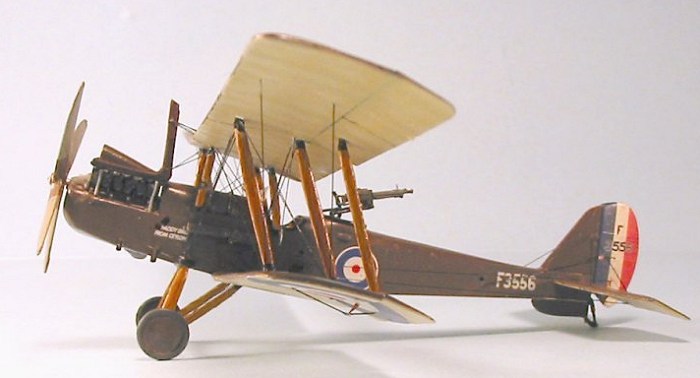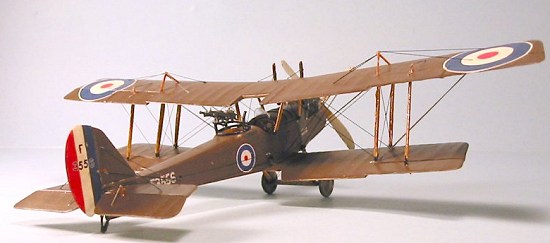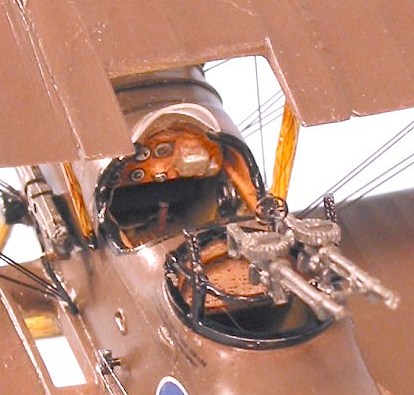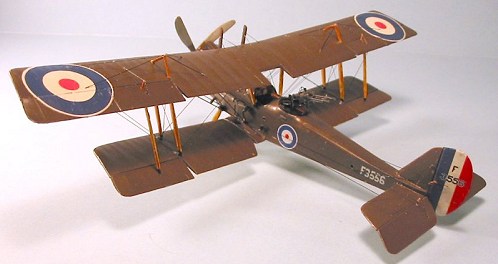
Aeroclub 1/48 Re.8
|
KIT # |
? |
|
PRICE: |
$45.00 when new |
|
DECALS: |
Five options |
|
REVIEWER: |
Tom Cleaver |
|
NOTES: |
Currently (2004) out of production |

|
HISTORY |
The roots of "'Arry Tate," as the R.E. 8 (Reconnaissance Experimental,
Model 8) was known to its crews, goes back to the creation of the B.E.
(for Bleriot Experimental) series. The B.E.2, which appeared in B.E.2c,
B.E.2d and B.E.2e versions, was the primary corps reconnaissance aircraft
of the Royal Flying Corps from 1914 until the R.E.8 began to replace it
on the Western Front in late 1916. It was a pilot in a B.E.2 who first
spotted the German army shortly after it had turned left toward Paris as
it came out of Belguim; that his warning was taken seriously by a ground
commander was as big a miracle in itself as
 the "Miracle of the Marne"
it led to by allowing the British Expeditionary Force to withdraw before
being surrounded and for the French to use the taxis of Paris to get men
to hold on the Marne. The First World War would have been the six week
conflict everyone expected - and ended with German victory - but for that
lone pilot in his already-obsolete airplane.
the "Miracle of the Marne"
it led to by allowing the British Expeditionary Force to withdraw before
being surrounded and for the French to use the taxis of Paris to get men
to hold on the Marne. The First World War would have been the six week
conflict everyone expected - and ended with German victory - but for that
lone pilot in his already-obsolete airplane.
The B.E.2 made the serious design mistake of putting the pilot in the back seat; at a time when aircraft were unarmed and unlikely to be armed, putting the observer in front supposedly gave him a better field of view. When it came time to arm airplanes against the "Fokker scourge," the observer was provided with a Lewis gun on a pivot between the two cockpits, with a limited field of fire directly to the rear, over the pilot's head. With a top speed of 75-80 m.p.h., the B.E.2s were sitting ducks for German Jagdflieger mounted in Albatros fighters, and they were shot down in droves during the Somme campaign in the summer and fall of 1916 and on through Bloody April in 1917, when the average operational life of an R.F.C. pilot was 7 hours once he arrived at the front with as little as 20 hours total flying time and was assigned to a squadron equipped with the type.
" 'Arry Tate" was not that much of an improvement over his predecessor. The airplane came into existence in 1916 as a result of the perceived need to create an airplane with superior performance and hence better survivability than the B.E. series.
The main item of improvement was that
the seating order was reversed, with pilot and observer/gunner seated
back-to-back which allowed better coordination; the gunner's weapons were
mounted on a Scarff ring that allowed a full 360 degree field of fire,
with either one or two Lewis guns. Whil e
the addition of a second weapon added to an already-heavy load, the fact
that the R.E.8 only had a top speed of 90-95mph meant many crews decided
they would give the enemy a hot reception since it was unlikely they
could run away. The R.E.8 began to replace the B.E. in the corps
reconnaissance squadrons in late 1916, and had a survival rate during
"Bloody April" of 1917 slightly better than the B.E.- equipped units, due
to its improved defensive armament. By that summer, the aircraft had
replaced all of the dreadful B.E.s on the Western Front, and had also
been adopted by the Belgian Air Force.
e
the addition of a second weapon added to an already-heavy load, the fact
that the R.E.8 only had a top speed of 90-95mph meant many crews decided
they would give the enemy a hot reception since it was unlikely they
could run away. The R.E.8 began to replace the B.E. in the corps
reconnaissance squadrons in late 1916, and had a survival rate during
"Bloody April" of 1917 slightly better than the B.E.- equipped units, due
to its improved defensive armament. By that summer, the aircraft had
replaced all of the dreadful B.E.s on the Western Front, and had also
been adopted by the Belgian Air Force.
By early 1918, the production level of the far-better Bristol F.2B Fighter - which had originally been designed as a competitor to the R.E.8 - had reached the point it could be diverted to the corps reconnaissance squadrons, and it began to replace the R.E.8 on the Western Front. The airplane continued in widespread use in the Middle East, and was never completely supplanted on the Western Front before the end of the war.
An �Arry Tate Ace:
Little is made of the fact nowadays that there were in fact many �gunner aces� among the R.F.C. and R.A.F. Including quite a few with double-digit scores and a several with scores over 20; the overwhelming majority of these gunner aces were rear-seaters on Bristol Fighters, an airplane that genuinely was a two-seat fighter.
Among the more memorable of these men is Lt. Harvey Rhoads of 12 Squadron, who - between May 7 and September 3, 1918 - scored an amazing eleven victories as the observer in an R.E.8, the only R.E.8 gunner to score sufficient victories to be recorded in the record books. Flying with Lt. Croye Pithey in B7715 and Lt. Noel Garland in F6097, Rhoads shot down two observation balloons, three Pfalz D.IIIs, two Fokker D.VIIs, a DFW C.V and two LVG two-seaters. When one considers the kind of defenses that were mounted around observation balloons, the fact that Rhoads and Pithey destroyed two on separate occasions in May and June 1918 demonstrates some very great courage and superior skill, as well as an enormous helping of luck.
Obviously, �Arry Tate wasn't always a target.
|
THE KIT |
There has only been one other
injection-molded kit of the R.E.8 ever produced, a now-decidedly-elderly
kit from Airfix which first appeared in the late 1950s, in 1/72 scale.
Thus, World War I modelers were excited to hear of the impending release
of the airplane as a mixed-media limited-run k it
from Aeroclub of England, in 1996. The kit appeared the summer of 1997
and received good reviews in the Great War specialty magazines. At
a price of $45, and with a reputation as a real "bird cage" when it came
to rigging, it was not a model for the beginning biplane modeler.
it
from Aeroclub of England, in 1996. The kit appeared the summer of 1997
and received good reviews in the Great War specialty magazines. At
a price of $45, and with a reputation as a real "bird cage" when it came
to rigging, it was not a model for the beginning biplane modeler.
The basic airframe comes in light brown, limited-run injected plastic with a slightly-heavy surface detail that reveals its ancestry as the product of a very good vacuform company. The detail parts are all in white metal, and are of the quality modelers can expect of Aeroclub, producer of the best white metal detail parts available anywhere. Decals are provided for four different RFC/RAF aircraft, and one Belgian version.
The model is now out of production, though it may still be available direct from Aeroclub, and can be found from time to time on dealers tables at model shows. It still sells for about its original asking price, a tribute to its quality.
|
CONSTRUCTION |
I have previously done an
article on building this model, one of the very very early reviews found
here. However, over the recent Christmas holiday I managed to give the
old model an accidental flying lesson, which resulted in thirty minutes
being spent collecting the far-flung parts from off the floor and
deciding what to do with the wreckage. G iven
there is no replacement, since the kit is now long out of production, and
the fact that the R.E.8 is one of my favorite WW1 two-seaters, I decided
to rebuild the model, applying the skills I have developed in the last
eight years to the project.
iven
there is no replacement, since the kit is now long out of production, and
the fact that the R.E.8 is one of my favorite WW1 two-seaters, I decided
to rebuild the model, applying the skills I have developed in the last
eight years to the project.
Thus, this review is a combination of the first build (Don't go looking for it as I've written over it. Ed), where I did the interior that was not rebuilt, and the restoration project.
As with most models, construction begins with the cockpit. I first painted the interior with Gunze "Sail Color" to represent clear doped linen, then painted the raised airframe detail in a self-mixed honey-brown shade to simulate English ash, which is the wood it was made from. For other areas of wood inside the airplane, and for all the struts, I used a "medium wood color" decal sheet I picked up long ago from MicroScale. I also used decals for the instruments on the basic panel. Once that was completed, I glued the fuselage together. Having learned the first time that all the white metal parts in the forward fuselage made the model decidedly nose-heavy, I took the opportunity during the restoration to drop some fishing weights in the rear fuselage to balance things out.
The control surfaces had been cut loose from the wings and tail surfaces, and were re-posed as though the stick and rudder pedal had been thrown to the right by the pilot as he climbed out of the cockpit. The lower wings and tail surfaces were glued to the fuselage and set aside to set. I also glued the three piece (now five piece counting the separated ailerons) upper wing together and put it aside with bracing to set up. I also applied Mr. Surfacer to the various seams on the fuselage, which was later sanded smooth.
I painted the white metal engine in various metallic shades, using Testors Metalizer paints, then gave it a light coat of Tamiya "Smoke" to bring out detail and seal the metallic paint.
|
COLORS & MARKINGS |
Painting:
 First, I pre-shaded
the model with flat black over all the ribs and other panel lines.
First, I pre-shaded
the model with flat black over all the ribs and other panel lines.
The model was painted the standard British colors of clear doped linen undersurfaces done with Gunze �Sail Color,� and the upper camouflage color of P.C.10, which I mixed myself - going for the brownish tinge of some variants of this color - using Gunze Dark Earth, Tamiya Khaki, and Tamiya Olive Drab. Once this was dry, I Futured the model and set it aside to dry.
Decals:
Fortunately, John Adams still had left-over decals for the kit, and an e-mail to him resulted in a sheet turning up in the mail a week later, so that I could do "A Paddy Bird From Ceylon," the sole surviving R.E.8, which has been restored and is now on display at the Imperial War Museum facility at Duxford, for which I was able to find good color shots at the WW1 Modeling Website. (Editor's note: a reader has informed me that a Hispano powered Re.8 is extant in Belgium as well.)
The older Aeroclub decals are a bit thicker and not as sharp as one would get from Aeromaster or one of the other aftermarket companies, but the result is very acceptable. The decals went on with no problem and settled under a light prodding from MicroSol. Once they were dry, the model was Futured once again.
Final Assembly:
I attached the engine in
position, then attached the interplane and cabane struts, using
cyanoacrylate. When these had set up, I attached the upper wing, again
using cyanoacrylate and zip kick er
to accomplish the final set up quickly. Landing gear and prop and rear
gun armament were the last to go into position.
er
to accomplish the final set up quickly. Landing gear and prop and rear
gun armament were the last to go into position.
Rigging:
Progress now stopped. The airplane is a mass of rigging, all done with what are called "raf wires", which are the flattened, airfoil-shaped wires the British invented in 1916. While .008 stainless steel wire is round in section, the result looks acceptable. I painted the wires gloss black, as shown in the photos of the restored airplane.
The actual rigging of 'Arry Tate took the better part of two days with breaks, much less than I had estimated. The result is one of those First World War airplanes that truly deserves the sobriquet "bird cage."
|
CONCLUSIONS |
The R.E.8 is one of the most important aircraft used by the Royal Flying Corps and the Royal Air Force during the Great War, and as such deserves a place in any collection of models of aircraft from that period that claims to be truly representative. The kit is still available for the modeler who wants to look around for it, and is not as difficult as it looks. While this is by no means a "first biplane model," assembly is straightforward and presents no difficulties that cannot be solved by taking your time.
|
REFERENCES |
Name: Harvey Rhodes
Country: England
Rank: Lieutenant
Service: Royal Flying Corps
Royal Air Force
Unit: 12 Sq
Victories: 11
Born: 12 August 1895
Place of Birth:
Died: 11 September 1987
Place of Death: Oldham, Lancashire
Victories Date Time Aircraft Opponent Location
1 07 May 1918 R.E.8 Balloon (DES) 1
2 08 May 1918 R.E.8 EA (OOC) 2
3 04 Jun 1918 0920 R.E.8 (B7715) Balloon (DES) 1 57C B8
4 07 Jun 1918 0920 R.E.8 (B7715) Pfalz D.III (DES) 1 57C B8
5 07 Jun 1918 0920 R.E.8 (B7715) Pfalz D.III (OOC) 1 57C B8
6 07 Jun 1918 0920 R.E.8 (B7715) Pfalz D.III (OOC) 1 57C B8
7 21 Aug 1918 1130 R.E.8 (E47) Fokker D.VII (OOC) 1 Behaignies
8 23 Aug 1918 1740 R.E.8 LVG C (DESF) 1 Boyelles
9 28 Aug 1918 0945 R.E.8 (F6097) DFW C (DES) 1 E of St. Leger
10 30 Aug 1918 0650 R.E.8 (F6097) Fokker D.VII (DESF) 1 Bullecourt
11 03 Sep 1918 1715 R.E.8 (F6097) LVG C (DES) 1 Lagnicourt
April 2004
Copyright ModelingMadness.com If you would like your product reviewed fairly and fairly quickly, please contact
the editor or see other details in the Note to
Contributors.